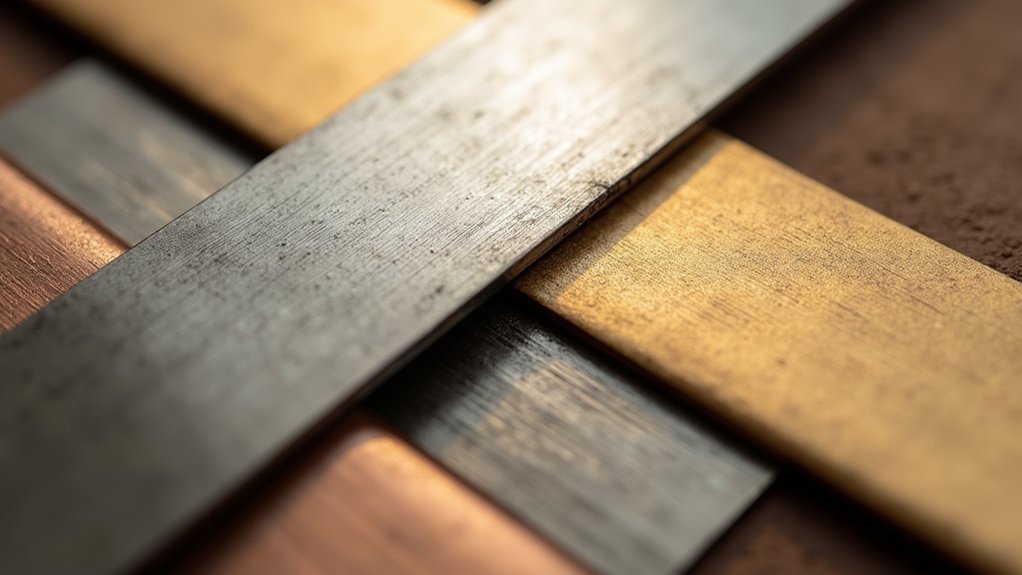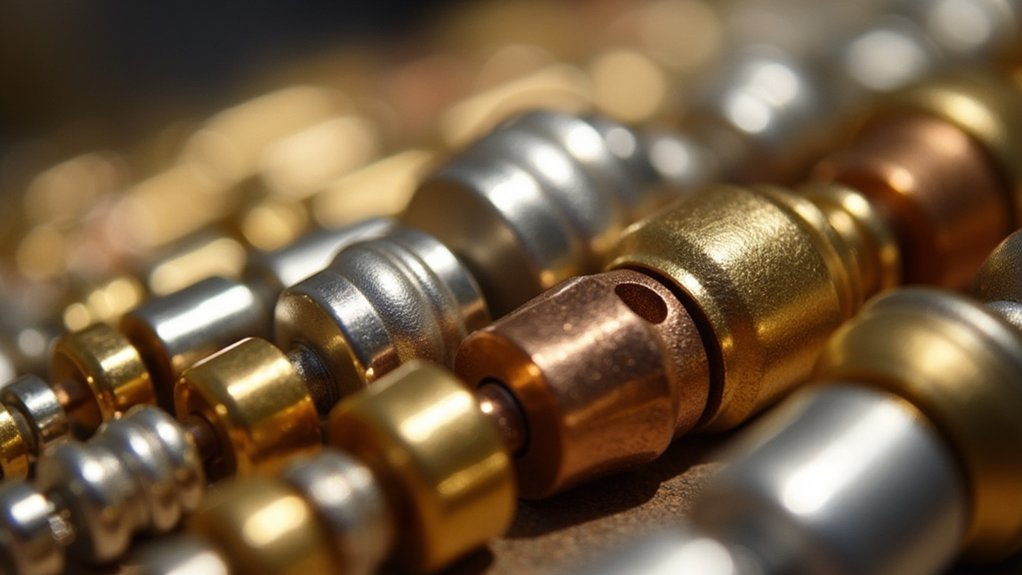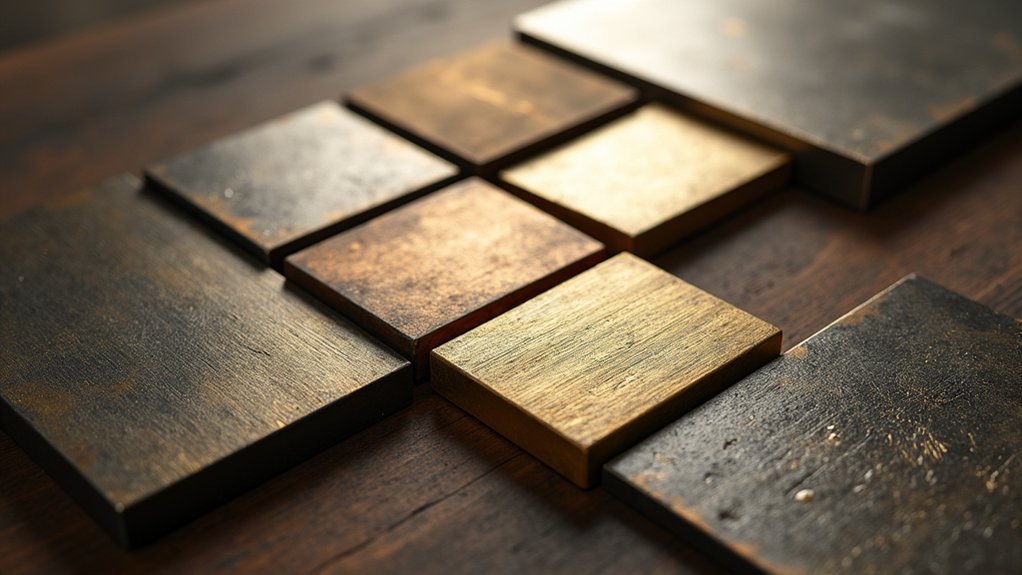You’ll master mixed metal finishing by choosing one dominant metal for 60% of your elements, then limiting your palette to three metal types maximum. Mix warm metals like brass with cool options like chrome for contrast, and use the 60-30-10 rule for proportions. Position different finishes at varying heights to prevent competition, maintain consistent textures across similar pieces, and strategically space metals several feet apart. Consider how patina develops over time for long-term harmony. These foundational principles reveal advanced techniques for professional-looking results.
Master the Art of Layering Different Metal Textures

Mastering different metal textures transforms ordinary spaces into sophisticated design statements. When mixing metals, you’ll create compelling visual interest by combining matte, polished, and hammered finishes throughout your space.
Each texture should complement the others, working together to achieve a cohesive look rather than competing for attention.
Successful metal mixing requires textures that harmonize rather than clash, creating unified design flow throughout your space.
Avoid selecting metal finishes that are too similar in texture, as this creates visual chaos. Instead, strategically distribute varied tactile qualities to establish proper balance.
Position a sleek polished brass fixture near textured bronze hardware, or pair smooth stainless steel with rougher hammered copper accents.
The key lies in thoughtful placement—let each texture enhance the others while maintaining harmony. This layered approach elevates your design aesthetic and creates a richer sensory experience that feels intentional and professionally curated.
Choose Your Dominant Metal Finish First
You’ll want to establish your foundation metal selection strategy by picking one finish that’ll serve as your design anchor throughout the space.
Start by evaluating your existing finishes—whether it’s your kitchen appliances, bathroom fixtures, or architectural elements that aren’t easily changed.
This dominant metal should represent about 60% of your metallic elements and appear in your most prominent features like cabinetry hardware, major light fixtures, or plumbing.
Foundation Metal Selection Strategy
The most critical decision in any mixed metal design starts with selecting your foundation metal—the dominant finish that’ll anchor your entire space. This choice establishes your design’s backbone, influencing every subsequent decision about accent finishes and creating the framework for a cohesive look.
Your foundation metal should appear consistently across key elements like doorknobs, hinges, and major fixtures. Consider existing elements or personal preferences when making this choice, as it’ll greatly impact your room’s aesthetic and mood.
| Metal Strategy | Design Impact |
|---|---|
| Consistent Foundation | Creates unified harmony |
| Bold Contrasts | Generates stunning visual interest |
| Balanced Accents | Guarantees curated appearance |
Mixed metals work best when your dominant metal appears in multiple locations, while complementary accent finishes enhance the overall design without overwhelming the space.
Existing Finish Assessment
Before selecting accent metals, conduct a thorough inventory of your space’s existing finishes to identify which metal can realistically serve as your dominant choice.
Walk through your room and catalog every metal element you’ll keep, from doorknobs and hinges to light fixtures and cabinet hardware. This assessment reveals which finish already has the strongest presence in your space.
Your dominant finish should align with your personal style while creating a cohesive look throughout the area.
Consider whether you’re drawn to:
- Warm tones like brass, bronze, or copper for cozy, traditional atmospheres
- Cool finishes such as polished nickel, chrome, or stainless steel for modern aesthetics
- Neutral options like black or brushed metals that complement warm or cool palettes
This foundation guarantees visual harmony before introducing complementary accent metals.
Limit Your Palette to Three Metal Types Maximum

One of metal mixing’s cardinal rules involves restraining your selection to three finishes maximum per room.
When you limit your palette to three metal types, you’ll create a cohesive design that feels intentional rather than chaotic. This approach prevents visual overwhelm while still allowing creative expression.
Start with two different metal finishes if you’re new to mixing warm and cool tones.
Consider your room’s existing color palette and undertones to create balance between metals.
Apply the 60-30-10 rule: choose one dominant finish, add a secondary accent, and include a minor third finish for visual interest.
Ensure there’s distinct contrast between your selected metals.
Avoid choosing finishes too similar in color, as this creates confusion rather than the polished, harmonious look you’re seeking.
Balance Warm and Cool Metal Undertones
Understanding metal undertones is essential for successful mixed finishes in your space.
You’ll want to recognize that warm metals like brass and gold carry yellow or reddish undertones, while cool metals such as chrome and polished nickel display blue or silver undertones.
Creating visual temperature balance means strategically pairing at least one warm and one cool metal to generate contrast and depth without letting them compete against each other.
Warm Vs Cool Categories
When you’re selecting metals for your space, categorizing them into warm and cool tones becomes your foundation for creating visual balance. Warm metals like brass and gold bring richness and comfort, while cool metals such as chrome and polished nickel offer sleek sophistication.
Understanding this distinction helps you make intentional design choices. Mixing warm and cool metals creates striking contrast—pairing polished brass with silver generates compelling visual interest. However, you’ll achieve a cohesive aesthetic by grouping metals with similar undertones together.
Follow these guidelines for successful metal mixing:
- Identify undertones first – Brass and bronze share warm qualities that harmonize naturally.
- Create clear contrasts – Avoid confusing similar tones; choose distinct warm or cool pairings.
- Limit your palette – Too many mixed metals can overwhelm your design’s intentional flow.
Creating Visual Temperature Balance
Visual temperature balance transforms your metal mixing approach from basic categorization to strategic design execution. When you mix metals effectively, you’ll create visual contrast while maintaining a cohesive look throughout your space.
Balance warm and cool metals strategically by pairing brass or gold with chrome and polished nickel. This contrast prevents monotony while establishing sophisticated depth. You’ll achieve the best temperature balance when one metal serves as your unifying thread, weaving consistency throughout the design.
| Metal Type | Temperature | Best Pairings |
|---|---|---|
| Brass | Warm | Chrome, Matte Black |
| Gold | Warm | Polished Nickel |
| Chrome | Cool | Brass, Bronze |
| Copper | Warm | Avoid with Brass |
| Matte Black | Neutral | Any Metal |
Focus on complementary undertones rather than fighting them. Shiny metals effectively cool warm wood tones, creating dynamic visual interest.
Maintain Consistent Finishing Techniques Across Pieces

Achieving a polished mixed metal design hinges on maintaining consistent finishing techniques across similar pieces throughout your space.
When you’re working with mixed metals, visual harmony depends on how well you coordinate finishes across comparable elements like cabinet hardware, light fixtures, and plumbing fixtures.
Focus on these key strategies for success:
- Group similar finishes together – Apply brushed or matte finishes within the same category to create a cohesive look.
- Repeat one finish multiple times – Guarantee at least one finish appears in several locations for a unified appearance.
- Choose distinct textures – Avoid finishes that are too similar; instead, select options with clearly different characteristics.
Always verify product specifications between manufacturers, as finish variations can disrupt your carefully planned design scheme.
Create Visual Flow Through Strategic Metal Placement
Beyond selecting consistent finishes, you’ll need to map out where each metal appears to guide the eye smoothly through your space. Establish your dominant metal across key fixtures like lighting and hardware to create a cohesive foundation.
Map out your metal placement carefully to establish a dominant finish across key fixtures while creating intentional visual flow throughout the space.
Then position accent metals strategically in at least two separate locations to maintain intentionality and visual flow. Use varying heights when placing different metal finishes—install lighting fixtures higher and hardware lower to create interest without clutter.
Leave negative space between competing elements for clarity. Balance warm metals with cool metals when they’re positioned close together, ensuring visual harmony.
This strategic placement approach prevents your mixed metals from appearing random while maintaining purposeful design flow throughout your room.
Avoid Competing Finishes in Close Proximity

When you’re mixing metals, you’ll want to give each finish enough space to shine without creating visual chaos.
Strategic spacing prevents different metals from competing for attention, while varying the height of metal elements helps establish clear separation between finishes.
This intentional placement allows each metal to make its own statement while contributing to the room’s overall design harmony.
Strategic Spacing Between Metals
Strategic placement of different metal finishes throughout your space prevents the chaotic appearance that occurs when competing finishes crowd together.
You’ll create visual harmony by implementing strategic spacing that allows each metal to shine independently.
Consider these essential spacing techniques:
- Maintain negative space of several feet between metals on the same visual plane to prevent direct competition.
- Use height differentiation to position different finishes at varying levels, separating fixtures from hardware vertically.
- Distribute metals across multiple locations to guarantee each finish appears at least twice for cohesive appearance.
You should also evaluate color temperature and undertones when planning placement.
Warmer and cooler metals naturally work better when they’re not fighting for attention in cramped quarters, allowing your intentional design choices to create sophisticated visual flow.
Height-Based Metal Separation
Vertical separation creates sophisticated visual layers that prevent mixed metals from clashing within your design scheme. When mixing metal finishes, you’ll achieve better visual appeal by strategically placing different materials at varying elevations throughout your space.
Height differentiation allows you to establish a clear hierarchy where each finish occupies its own designated zone. Start by assigning specific metals to different fixture levels—use brass for upper lighting, chrome for mid-level faucets, and bronze for lower cabinet hardware.
This intentional placement draws the eye across multiple planes while maintaining design coherence. Add a third accent metal through mirrors or decorative elements at intermediate heights to create depth without overwhelming the space.
This systematic approach guarantees your mixed metals complement rather than compete with each other.
Use Transition Metals to Bridge Contrasting Finishes
Although mixing warm and cool metals can create striking contrast, shift metals like brushed nickel and satin brass act as the perfect mediators in your design scheme.
Bridging warm and cool tones, intermediary metals like brushed nickel create harmonious transitions that elevate any mixed-metal design scheme.
These intermediary metals possess neutral qualities that complement both warm metals like gold and cool metals like chrome, creating seamless visual connection between contrasting finishes.
Strategic placement makes all the difference in achieving your mixed metal look:
- Focus on key touchpoints – Install intermediary metals on frequently used items like faucets, cabinet handles, and light switches.
- Consider texture carefully – Matte finishes soften harsh contrasts while polished finishes create vibrant connections between different metals.
- Unify through repetition – Use the same intermediary metal in multiple locations to create intentional cohesion throughout your space.
Consider Patina Development Over Time

When planning your mixed metal scheme, you’ll want to think beyond the initial installation and consider how your finishes will evolve over time.
Patina development through natural aging can dramatically transform your mixed metals, affecting their aesthetic appeal and the visual balance you’ve carefully created. Copper and brass will develop greenish or darker patinas, while other metals age differently.
You can either embrace this evolution or control it through regular maintenance.
If you choose metals that develop patina at similar rates, you’ll achieve a more cohesive look as they age together. This approach adds intentionality to your design, allowing the natural aging process to enhance rather than disrupt your original vision.
Test Metal Combinations Before Final Assembly
Understanding how metals will age helps inform your initial selections, but you’ll want to see exactly how your chosen finishes work together before committing to the full installation.
Before proceeding with your project, test metal combinations systematically to verify visual appeal:
- Gather samples of all finishes and evaluate them together in the actual lighting conditions of your space.
- Create a mood board combining metal samples with paint colors and fabrics to visualize the complete design interaction.
- Experiment with small items like drawer pulls or picture frames to see combinations in practical contexts.
Pay close attention to undertones—warm metals like brass and bronze create cohesion, while mismatched undertones cause visual discord.
Consider how varied textures enhance interest but require careful balance to avoid clashes.
Frequently Asked Questions
What Is the Rule for Mixing Metals?
You should limit yourself to 2-3 metals per space, choose one dominant metal as your foundation, mix warm and cool tones carefully, and follow the 60-30-10 proportion rule for balance.
How Do You Mix Metals Successfully?
You’ll successfully mix metals by choosing one dominant finish and limiting accents to two additional metals. Balance warm and cool tones intentionally, vary textures like matte and polished, and distribute finishes evenly throughout the space.
Is It Okay to Mix Metal Finishes in a House?
You can absolutely mix metal finishes throughout your house. It’ll add character and visual interest to your spaces. Just limit yourself to 2-3 different metals per room for the best results.
What Metals Should Not Be Mixed?
You shouldn’t mix brass with gold since they’re too similar, copper with brass due to clashing undertones, or warm metals like brass with cool chrome without clear intention. Avoid combining more than three metal types.
In Summary
You’ll achieve professional mixed metal results by starting with a dominant finish and limiting yourself to three metals maximum. Remember to balance warm and cool undertones while maintaining consistent techniques throughout your project. Don’t place competing finishes too close together, and use intermediary metals to create smooth visual bridges. Always test combinations beforehand and consider how patina will develop over time for lasting, cohesive results.





Leave a Reply